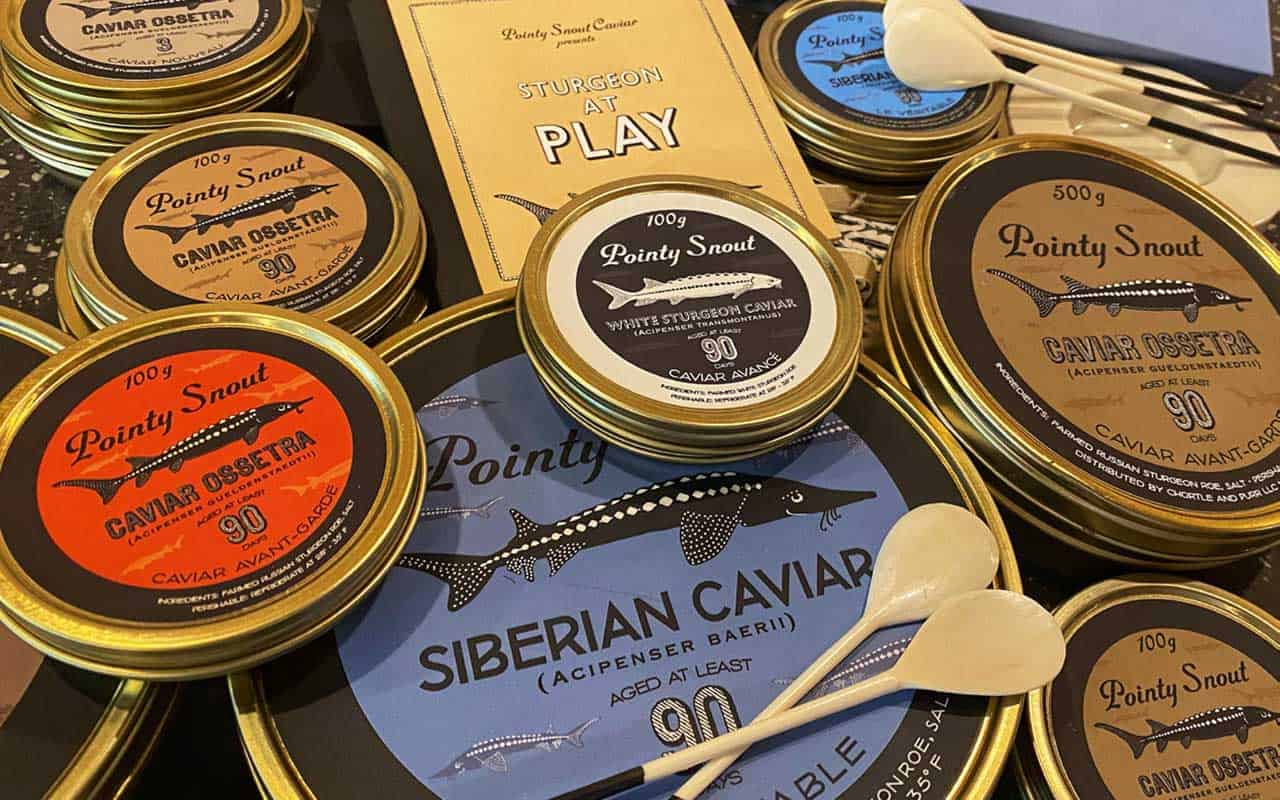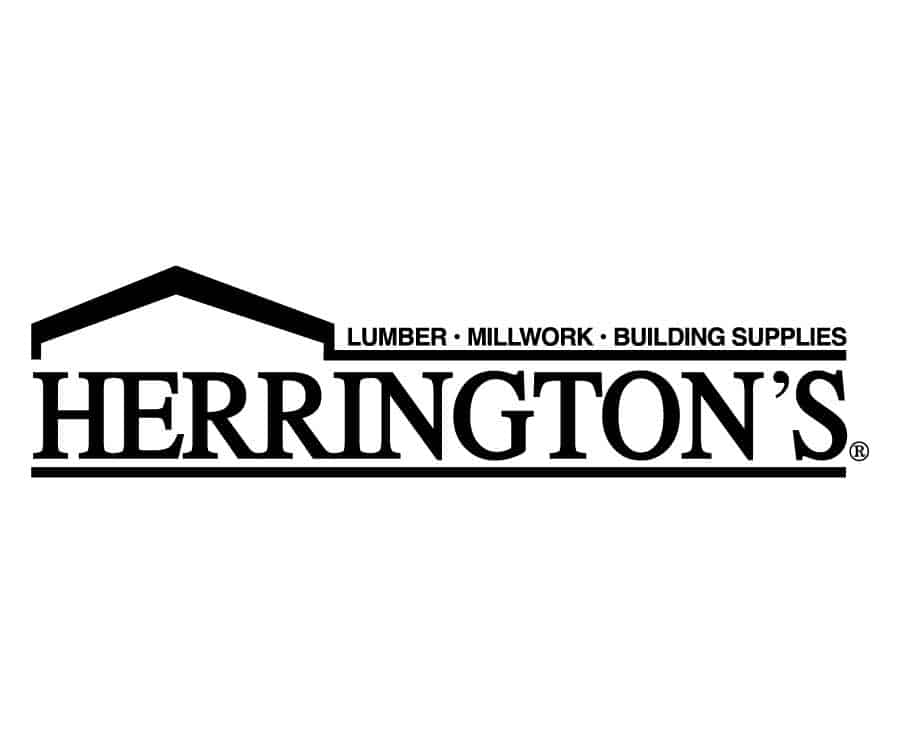Main Street Business

Catchy Caviar in Millerton
Does it seem unlikely that fine caviar from all over the world is shipped to Millerton, NY, to be repackaged and sold to American consumers? After seeing Pointy Snout Caviar tins in Westerlind Pantry I wanted to find out more and interviewed Alex Du Cane and Michael Kline. They started this boutique, caviar business ten years ago after careers in fashion and finance.
Pointy Snout? How did you decide on that name?
ADC: A group of us were sitting around looking at photos of sturgeon when someone piped in with the obvious: “Look, they all have pointy snouts.” At the time, we’d put together many key elements of the brand, but we hadn’t yet come up with a name. “Pointy Snout” seemed to convey subtle layers of attributes and values we wanted the brand to evoke: acknowledgement of, and respect for, the heroic fish; an irreverence towards traditional branding nomenclature playful rule-breaking; fun, even whimsical; accessibility – meaning, mostly, the banishment of intimidation; responsibility, expressed through a commitment to sustainability and transparency.
Why are you in downtown Millerton?
ADC: We had lived full-time in Litchfield County for 27 years, but our business model was somewhat New York-centric. Though we’ve always shipped to clients throughout the US, Europe, and Asia, we had focused especially on chefs in New York City and California. So, for the first seven years, we staged our packing and fulfillment operations in a Long Island City warehouse. That meant we were making 2-3 day trips to the city each week. One day we got the bright idea that all the back-and-forth was unnecessary. After all, where we packed had no bearing on where our customers were. We were living in a landscape of vast bucolic beauty where a distinct “real” food lifestyle was ascendant. Why not make Litchfield County, the Hudson Valley, and the southern Berkshires part of our celebration? We decided to bring our packing operation “in house” – which is to say, to our own neighborhood. The first step was to make new relationships with top-ranked sturgeon aqua farms throughout the world, and to import caviar directly from them, in bulk. For 18 months, the White Hart in Salisbury, CT, generously allowed us the exclusive use of a walk-in cooler, where we stored our caviar. Through friends at a local boarding school, we arranged to pack our caviar in an under-utilized industrial kitchen on campus. It all worked wonderfully until the pandemic arrived. At that point, we had no choice but to create our own accommodation. This led to our now permanent packing facility in a former Millerton café.
This is your idea of retirement?
MK: Well, we naively thought it was going to be easy. We had built businesses together, but we wanted to start something completely new – new to the marketplace, new for us. Alex had been a very successful agent for fashion photographers, with offices in Los Angeles, New York, and Paris. My background was in investment banking. In caviar, we saw an inviting opportunity to reposition a traditional luxury category and give it an unexpected, contemporary point of view. As it happened, at our launch ten years ago, we caught a wave. Within a week, we had become the featured brand at LVMH-owned Domaine Chandon in Napa. Influential magazine editors quickly followed. Without any formal PR effort, we began to appear regularly in Town & Country, Vogue, and other mainstream glossies. Three years out, Daniel Boulud referred us to the WSJ for a Christmas article. The results, in sales and brand recognition, were unimaginable.
How did you get into this business?
MK: As a finance guy, I had been retained by an absentee owner to recapitalize his caviar company that was based in northern California. A two-month gig turned into 18 months, with my flying to San Francisco and back virtually every week. Harrowing, but educational. In the end, Alex and I felt we knew as much about the business side of caviar as any veteran. We spent another year visiting farming operations around the world. At the same time, we began laying groundwork for the brand by collaborating with a creative shop in Paris which worked with Cartier, Hermes, and other premier luxury brands. That’s the part that really excited us and pushed us to go to market.
What makes Pointy Snout different?
ADC: To be blunt, without branding and purposeful differentiation, caviar is a commodity. The overwhelming proportion of caviar is very middle to low grade, and ends up at Costco or on passenger cruise ships and airlines. We built our brand DNA – at the time, a conscious departure from the pack – around a commitment to quality (only the top 5% of every harvest), transparency (telling consumers truthfully where the stuff came from), sustainability, and intense customer service. Would you believe driving from Salisbury to NYC at 10pm to deliver caviar to Ignacio Mattos?
“Sustainability” is an interesting case in point. Ten years ago, most caviar marketing pros – for that matter, most everyone involved in luxury goods writ large – dismissed, or outright laughed at, our emphasis on sustainability. Today, of course, every marketer for every product in the spectrum has jumped on the bandwagon. But, genuinely sustainable production still has a specific meaning. From a biological perspective, we rely on guidelines promulgated by the Monterey Bay Aquarium: “sustainability is measured by the degree of impact on the wild species.” In aqua farming, absolute sustainability is reflected by a 1:1 ratio between the amount of wild seafood used to feed and raise an equal amount of farmed fish. More broadly, sustainability is
reflected in the degree of impact on the environment – that is, in the replaceable units of water, energy, and labor that contribute to production.
Is water recycled? Are energy inputs self-generated, or minimized? Are local farm workers and craftspeople treated respectfully and given fair financial and benefit compensation? We source from suppliers whose answers to those questions are “yes.”
Caviar is farmed?
ADC: Historically, 90% of global caviar production was centered on the Caspian and Black Sea regions. Following the collapse of the Soviet Union, many former Soviet states, desperate for cash, began plundering wild sturgeon in search of one of the few tradeable currencies available to them – caviar. Throughout the ‘90s, an epic ecological disaster unfolded in the Caspian Sea. Rampant, state-sanctioned poaching and pollution decimated sturgeon populations, rendering several entire species extinct. By 2000, fewer than 100 beluga sturgeon had survived. Two forces saved sturgeon and the caviar industry. First, the Convention on International Trade in Endangered Species (“CITES”) banned all trade in Caspian caviar. CITES continues to monitor and regulate the amount of caviar each country can legally export each year. Second, sturgeon aqua farming, begun in the ‘80s in northern California, began to proliferate. At first, these farms raised sturgeon solely for fresh meat markets; they threw the roe away. Gradually, as the supply of “wild sturgeon” tightened and then disappeared, farm-raised sturgeon became the only source of legally consumed caviar. Today, there are caviar-producing sturgeon farms in over 50 countries, including major US facilities in California, Florida, Idaho, and North Carolina. Not only are wild fish protected by CITES. As part of their operating protocols, farms re-populate rivers by routinely releasing genetically healthy sturgeon back into their natural habitat.
Where does Pointy Snout Caviar come from?
MK: We source globally and, as mentioned, only from sustainable producers. Depending on the type of caviar involved, we buy the highest grade of each harvest from producers in California, Uruguay, Israel and, believe it or not, Madagascar. Incidentally, early in the 20th century, Hudson River sturgeon provided great quantities of caviar that ended up in lower Manhattan sailors’ bars – as free bar food, later to be replaced by salty peanuts, meant to encourage thirst. Over time – as in the Caspian Sea – sturgeon up and down the East Coast were overfished, blocked by dams from ancestral migration, and polluted to death. They are today legally protected from commercial operators.
Could you explain the different types of caviar Pointy Snout sells?
ADC: Out of roughly eight species (including “hybrids”) on the market, we feature three kinds of caviar. Our biggest seller is Ossetra (Acipenser gueldenstaedtii), also known as Russian Sturgeon. We sell several grades of Ossetra, with a medium to large bead size and either a dark amber or a golden color. Our second offering is Siberian Sturgeon caviar (Acipenser baerii), with generally smaller and darker beads. Third is caviar made from White Sturgeon (Acipenser transmontanus), with generally medium-sized and darker brown or black beads. Each type is distinctly different from the other; each has its own pleasurable merits. In addition to caviar, we offer caviar spoons that I designed and have hand-carved by artisans in Kenya. The spoons are made of camel bone, look exactly like ivory, and represent our emphatic opposition to the ivory trade. Nobody ever killed a camel for its bones. We offer personalized gift boxes that have been used to acclaim by designer brands and lux department stores such as Bergdorf’s, and Nordstrom.
How long does it take to produce caviar?
ADC: In the wild, some sturgeon need 17 years to reach roe-producing maturity. Farmed, the time ranges from five to 12 years, depending on the species. Females are identified at around age two; microchips are then embedded to help determine the exact time eggs should be harvested. It is important to note that the entire fish is used for commercial purposes, including medicinal. For example, it is not widely known, but there is an enormous market for fresh sturgeon meat in many countries.
Who are your customers?
ADC: While the restaurant and hotel markets largely disappeared during the pandemic, our private client segment increased in size and importance. Historically, our sales mix was split roughly 50/50 between wholesale clients (exclusive high-end restaurants, hotels, and retailers) and individuals. Prominent wholesale venues included New York restaurants Daniel, Café Boulud, Café Flora, and BG at Bergdorf’s. Estela and the Peninsula Hotel Beverly Hills are among restaurants that continue to feature Pointy Snout caviar by name on their menus. Prominent among our direct consumer segment is a network of repeat, high-net-worth private clients.
I should also mention that, while our marketing target continues to be global, we’ve developed a wonderful new portfolio of regional customers since moving our packing operations out of NYC. Apart from the organic publicity we receive in the media, most of our business is generated by word-of-mouth.
How do you two divide responsibilities between you?
MK: Alex does everything that’s critical to the brand. She’s the majority owner and CEO. She oversees communications, content, and design. She maintains relationships with suppliers and key clients. She’s one of the recognized handful of individuals in the US who have a “caviar” palate, so she tastes, packs, and controls overall caviar quality.
ADC: Michael focuses on the financial aspects of the business.
What is your biggest business challenge?
ADC: As mentioned, the pandemic’s devastating effect on the hospitality industry hit us hard. As we all know, restaurants are starting to rebound. For us, this represents slow, but steady, growing demand. Our goal is to capture old and new business as we head into our Christmas holiday sales season.
MK: Operationally, our biggest challenge is the cost and unreliability of FedEx delivery. The problem has grown worse since FedEx began nationwide delivery of Covid-19 vaccines. Because it’s caviar, we must ship all orders for priority, next day delivery. More than 20% of our shipments are not delivered within 24 hours. More than 10% are never delivered. Those failures represent a total loss for us.
What are you proudest of?
MK: We’ve endured. We’ve made a brand that’s caught the attention of creative directors, editors, designers, fashion and media tycoons, museums, executive chefs, captains of industry, and ordinary citizens.
What’s next for Pointy Snout?
Up to now, we’ve deliberately remained a “sleepy” brand. From time to time, we’ve retained sales and marketing professionals, but our brand essentially sells itself. Now, though, we see significant growth on the horizon. The big question we face is whether to gear up to capture a disproportionately bigger chunk of that growth. As part of this – and, it’s been in the back of our minds from the beginning – would be to roll out a collection of curated, one-of-a-kind luxury products not related to caviar or food.



